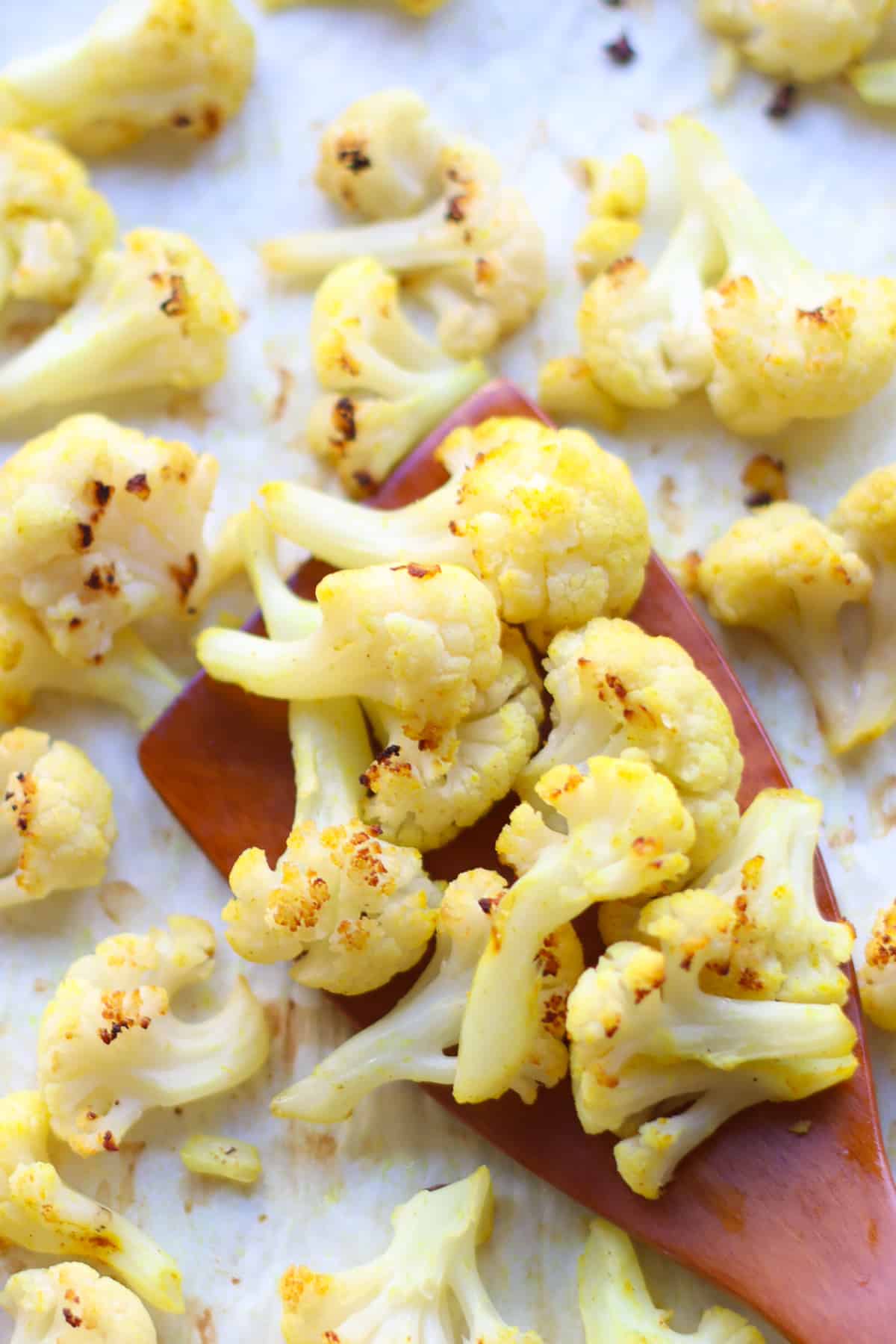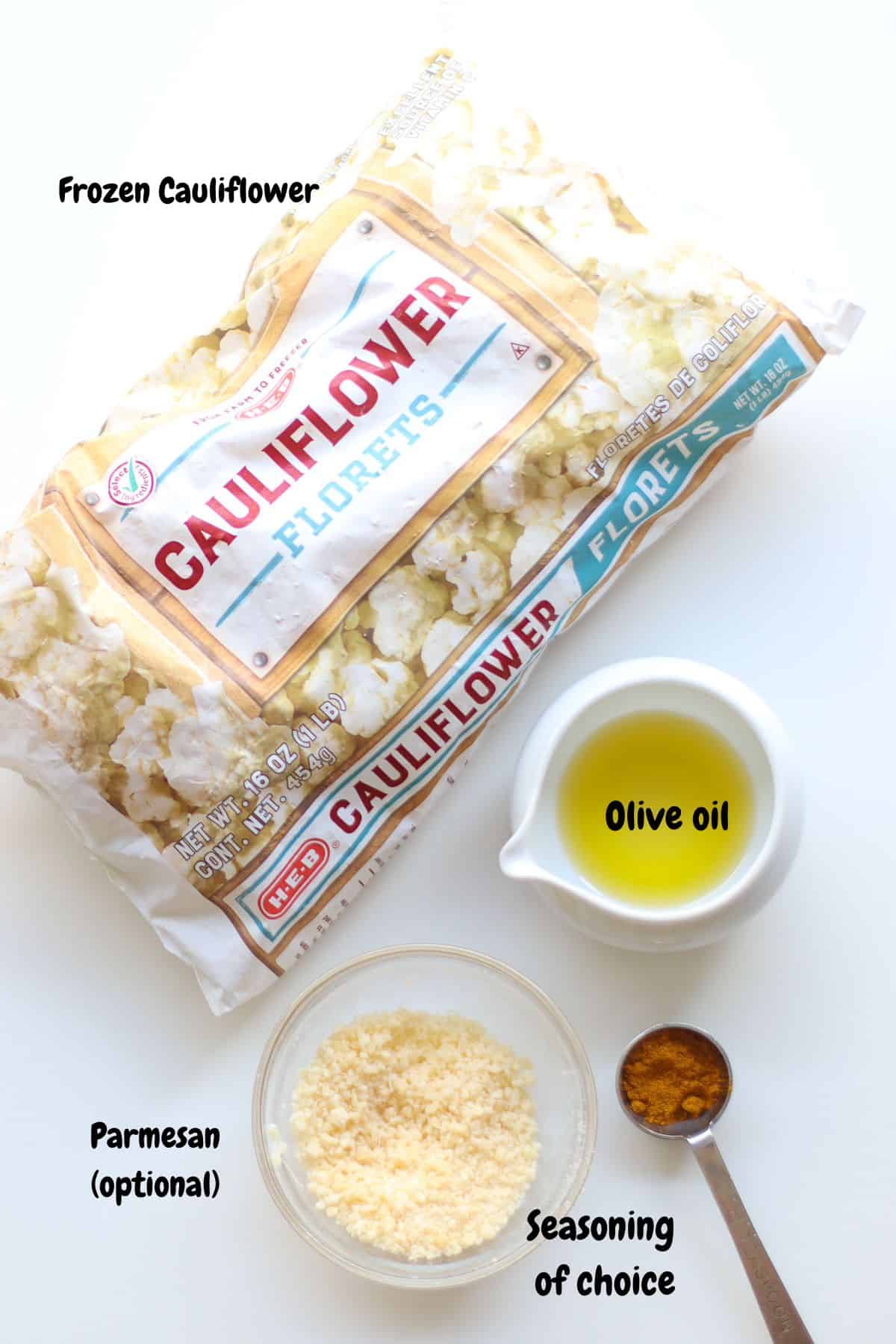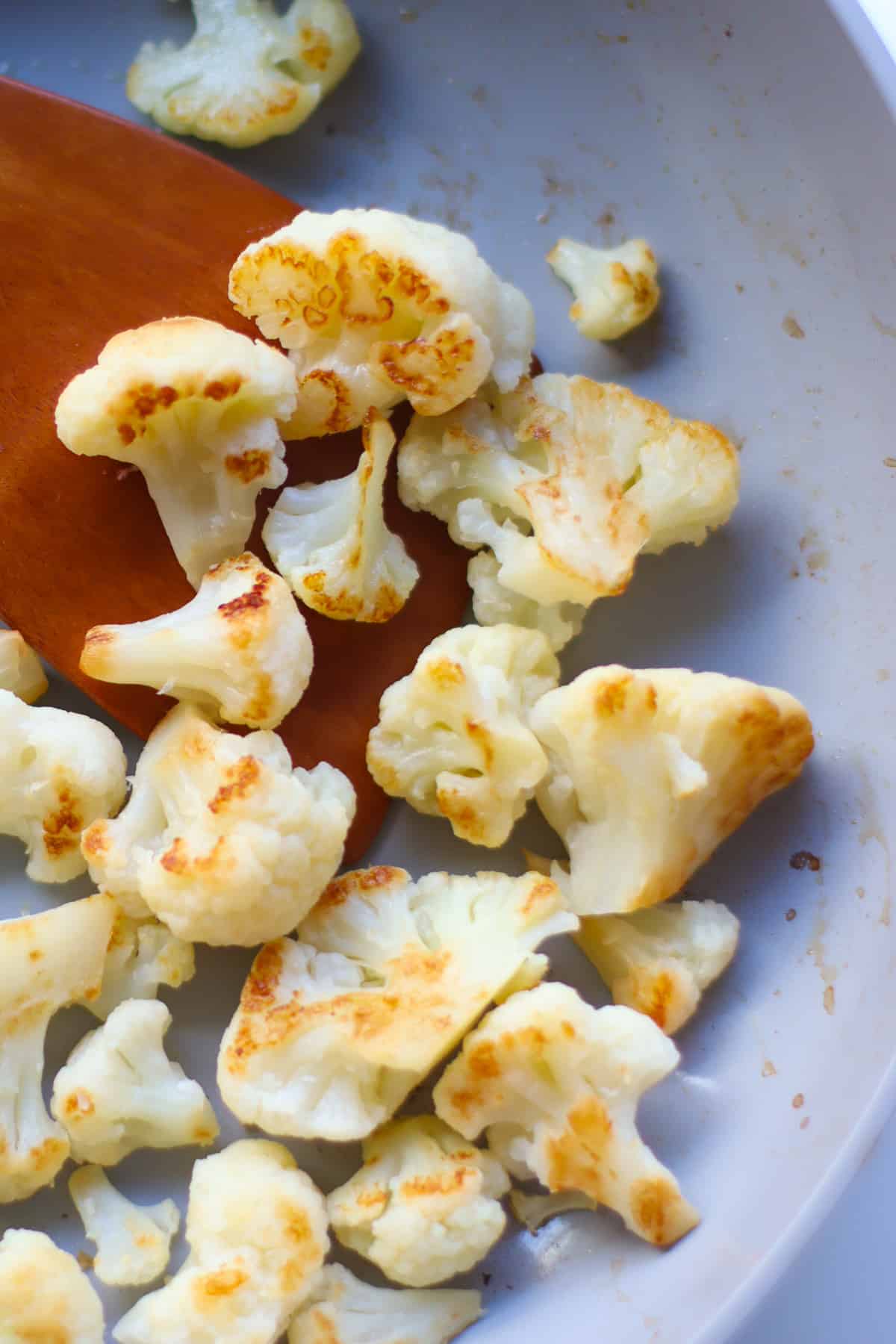This post may contain affiliate links. Please see our disclosure policy for more details.
Achieve flavorful and tender frozen cauliflower—never soggy—with these easy tips. Learn how to roast, sauté, steam, and microwave, and discover versatile ways to incorporate it into recipes.

Frozen Cauliflower
Having frozen cauliflower (or any frozen veggies) on hand is a game-changer – it’s just as nutritious (if not more!) as its fresh counterpart, budget-friendly, super convenient, and a hero in fighting food waste.
Keep it in the freezer until you’re ready to enjoy, and there are countless ways to turn it into something delicious!
And if you’re looking for more, here’s how to cook frozen green beans, frozen broccoli, frozen Brussels sprouts, and frozen peas. Did I mention I love frozen veggies? ;).
Table of Contents
Selecting the Best Frozen Cauliflower
The tricky part about picking the perfect frozen cauliflower is not being able to see what’s inside the bag. Quality and taste can vary between brands, so it’s a good idea to grab a bag from different stores when you can. Don’t overlook store brands either; they can be just as fantastic as the big names.
What I recommend is to feel the bag. If you feel large, solid masses or clumps, it may suggest that the cauliflower has thawed and refrozen, potentially affecting its quality.
And once you open it, there should be minimal ice crystals and no dark or off-color cauliflower.
My top favorites are 365 by Whole Foods, Costco, HEB, and Trader Joe’s.
What you want to avoid are seasoned cauliflower. The only ingredient you want to see is cauliflower.
Ingredients

- Frozen cauliflower florets
- Oil – Needed for roasting and sauteeing. Any neutral oil will work, like olive oil or avocado oil. I also love sesame oil for sauteeing.
- Seasonings – boosting the flavor of cauliflower is as simple as incorporating your favorite herbs and spices. Feel free to experiment and find the perfect combination that transforms your cauliflower from tasty to downright fabulous! Our favorites are garlic powder, onion powder, cumin, smoked paprika, turmeric, and curry powder.
How to Cook Frozen Cauliflower
There is no need to thaw the cauliflower for any of these cooking methods. Just add straight from the freezer!
Roast

Although the cauliflower might not achieve the same level of crispiness as freshly roasted cauliflower, it maintains a satisfying texture and can be flavored just as wonderfully!
For babies, I recommend steam roasting or steaming (see below) as the cauliflower needs to be very soft.
- Preheat oven to 425°F. Line a large baking sheet with parchment paper for easy clean up. I absolutely LOVE this sheet pan! They are super durable and conducts heat efficiently and evenly.
- Add the frozen florets to the baking sheet in a single layer, taking care not to overcrowd the pan. Place in the oven and roast for 10 minutes. This extra step assists in removing excess water, which will help your cauliflower get nicely browned and crisp.
- Remove from the oven and add oil and seasonings of choice. Toss with tongs until cauliflower is well coated.
- Place back in the oven and roast for another 10 minutes. If you want it to be extra crispy and brown, broil on high for 5 minutes or so.
- Sprinkle some parmesan cheese or nutritional yeast, if desired.
Saute

While many recommend thawing the cauliflower first, I’ve found this method to be easier and produces the most optimal texture.
- Add cauliflower to a large skillet or frying pan. Add 1/4 of water for every 1/2 pound (8 ounces) and cook covered until the ice from the cauliflower melts, about 2 minutes.
- Transfer cauliflower to a colander and shake off excess moisture. Wipe down the pan. Otherwise, oil will splatter everywhere.
- Add oil to the same skillet and heat over medium-high heat. Add cauliflower and saute for 5-7 minutes, taking care not to toss too much so the florets get a chance to brown.
- Add seasoning(s) of choice and a squeeze of fresh lemon always brightens it up.
Steam
- Place water in a pot, add steamer basket, and bring to a boil.
- Add cauliflower, cover, reduce heat to medium, and cook for 3-4 minutes, until tender. Transfer to a bowl and toss with seasoning(s) and lemon juice.
Microwave
- Place 1/2 pound of cauliflower and 2 tablespoons water into a microwave safe dish.
- Cover with a lid or microwave safe dish. Microwave on high for 2 minutes.
- Stir and cook for 2-3 additional minutes. It will take about 4-5 minutes. Strain and season.
Added to Recipes

There are plenty of ways to mix frozen cauliflower into your recipes, adding flavor, texture, and nutrition all in one go! They’re a great addition to:
- Creamy Cauliflower Dip
- Broccoli Cauliflower Soup
- Cashew Pasta Sauce
- Cauliflower Chickpea Soup
- Sweet Potato Quinoa Lasagna
- Healthy Chicken Nuggets
- Peach Banana Smoothie
Tips for Success
- Don’t thaw frozen cauliflower in the fridge or on the countertop. The pieces will get too soggy.
- Avoid overcooking! Frozen cauliflower is pre-boiled (or blanched in boiling water for a few minutes) before being quickly frozen, so it cooks faster than freshly chopped cauliflower.
Storage
For the best texture, I recommend enjoying the cooked frozen cauliflower right after preparing it. Yet, as a mom to toddlers, I also find it convenient to cook up a large batch to have easily throughout the week—you never know how much the little ones will eat!
In that case, allow the vegetables to cool before transferring to an airtight container. It will keep in the refrigerator for up to 5 days.
You can reheat briefly in the microwave or on the stove or enjoy cold, which is what we do most of the time.
You can also add the leftovers to easy meals like:
- Savory French Toast
- Oatmeal
- Broccoli Hummus Dip
- Baked Salmon Patties
- Veggie Nuggets
- Pizza Quesadilla
- Pizza Eggs
Frequently Asked Questions
Yes! Frozen cauliflower is harvested at peak ripeness, blanched, and flash frozen to preserve most of the nutrients, kill bacteria, and prevent spoiling.
The one difference is that the texture of frozen won’t be as crisp and, again, that’s because it’s already partially cooked.
You don’t have to! But if there’s a lot of ice on top rinse under running water for a few seconds.
You may come across recommendations to thaw (especially for sauteeing) in order to remove excess moisture. But follow my tips for each of the cooking methods and you will never have to face soggy, flavorless frozen cauliflower!
Did you make this recipe? Leave a rating below and let me know how you liked the recipe! Your feedback means so much to me!

How to Cook Frozen Cauliflower
Equipment
Ingredients
- 16 ounce bag frozen cauliflower
- 2 tablespoons olive oil or avocado oil
- 1-2 teaspoons seasoning(s) of choice
- (optional) Lemon juice, parmesan cheese
Instructions
Roast
- Preheat oven to 425°F. Line a large baking sheet with parchment paper for easy clean up.
- Add the frozen cauliflower to the baking sheet in a single layer, taking care not to overcrowd the pan. Place in the oven and roast for 10 minutes. This extra step assists in removing excess water.
- Remove from the oven and add oil and seasonings of choice. Toss with tongs until broccoli is well coated. Place back in the oven and roast for another 10 minutes. If you want it to be extra crispy and brown, broil on high for 5 minutes or so.
Saute
- Add cauliflower to a large skillet. Add 1/4 cup of water for every 1/2 pound (8 ounces) and cook covered over medium heat until the ice from the cauliflower melts, about 2 minutes.
- Transfer cauliflower to a colander and shake off excess moisture. Wipe down the pan.
- Add oil to the same skillet and heat over medium-high heat. Add back in the drained cauliflower and saute for 5-7 minutes, taking care not to toss too much. Add seasoning(s) of choice.
Steam
- Place water in a pot, add steamer basket, and bring to a boil. Add cauliflower, cover, reduce heat to medium, and cook for 3-4 minutes, until tender. Transfer to a bowl and toss with seasoning(s) and lemon juice.
Microwave
- Place 1/2 pound of cauliflower and 2 tablespoons water into a microwave safe dish. Cover with a lid or microwave safe dish. Microwave on high for 2 minutes. Stir and cook for 2-3 additional minutes. It will take about 5 minutes. Strain and season.
Notes
- Don’t thaw frozen cauliflower in the fridge or on the countertop. The pieces will get too soggy.
- Avoid overcooking! Frozen cauliflower is pre-boiled (or blanched in boiling water for a few minutes) before being quickly frozen, so it cooks faster than freshly chopped cauliflower.















Awesome You have covered all the questions I had and also given me more to explore!
Thank you!
Linda
I’m so glad this was helpful!!